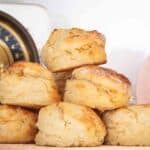Best Buttermilk Scones Recipe
A basic (but never boring!) buttermilk scones recipe, this makes super flaky scones which can be altered to suit a wide variety of different flavors.
Servings: 12
Calories: 191kcal
Ingredients
- 3 cups self-raising flour or all-purpose flour plus 3 teaspoons baking powder
- 1/4 tsp fine salt
- 2 Tbsp granulated sugar
- 6 Tbsp unsalted butter cool but not fridge-cold, chopped
- 1 1/2 cups buttermilk see notes for substitutes
- 2 Tbsp buttermilk extra, for brushing
Instructions
Preheat oven
- For conventional oven, preheat to 450°F/220°C. For steam oven, set to Combi Steam, 400°F/200°C, 30% humidity (if your steam oven doesn't have variable humidity, don't worry! Just set to combi steam at the correct temperature and the oven will sort out the steam for you). Line a baking sheet with parchment paper and set aside.
Make scone dough
- Place the flour, salt and sugar into a large mixing bowl. Add the butter. Using fingertips or a pastry blender, rub butter into flour mixture until mixture resembles coarse, lumpy breadcrumbs.3 cups self-raising flour, 1/4 tsp fine salt, 2 Tbsp granulated sugar, 6 Tbsp unsalted butter
- Make a well in the flour mix and pour in the buttermilk. Using a butter knife, stir and cut the mixture together until it forms a rough dough that almost comes together. Do not overmix. If it seems very dry you can add a little more buttermilk, but don't go overboard! You want a damp dough, not a muffin batter!1 1/2 cups buttermilk
- Turn the dough onto a lightly floured surface and use your hands to gently bring it together so it just forms a cohesive mass. Press out into a rectangle 1 1/2-inches/4cm thick.
Cut and bake scones
- Use a 2-inch/5cm round cookie cutter to cut scones (dip the cutter into flour between cuts to prevent dough sticking). Gently press leftover dough pieces together and cut these to make a total of 12 scones.
- Place scones, almost touching, onto the prepared baking sheet. Brush the tops with extra buttermilk and bake until light golden brown and puffed, about 15 minutes. If they're done, they'll sound hollow when tapped on top.2 Tbsp buttermilk
Wrap, cool and serve scones
- As soon as you remove the scones from the oven, cover them with a clean hand towel. This helps them stay soft and tender when cooled. Allow to cool until they're warm, then split and serve with jam and whipped cream.
Notes
- Flour: In Australia we can readily buy self-raising flour at the supermarket. If that's not the case where you are, you can substitute all-purpose flour mixed with 3 teaspoons baking powder. It's not an exact substitute but it will do fine here.
- Butter: The softness of the butter is key in this recipe; it needs to be just soft enough that you can rub it into the flour, but not so soft that it melts and blends in. I remove it from the fridge and cube it about 15 minutes before I'm ready to use it, and that works well.
- Buttermilk: cultured buttermilk makes the scones very tender and gives them a slight tang. If you're desperate for scones but have no buttermilk, mix regular milk with 1-2 teaspoons lemon juice or white vinegar and let the mixture sit for 5 minutes to curdle and thicken slightly.
- Variations:
- Blueberry Buttermilk Scones: add a cup of whole, fresh blueberries to the scone dough when you turn it onto the bench to bring together. Gently fold and squash them into the dough then proceed with cutting and baking. These are lovely with a quick glaze made from powdered sugar and fresh lemon juice.
- Chocolate Chip Scones: add a cup of chocolate chips to the bowl just after the buttermilk and proceed with the rest of the recipe.
- Date Scones: add 1/2 tsp cinnamon and 1/4 tsp nutmeg to the flour at the start of the recipe. Add 8-10 pitted and chopped dates to the bowl just after the buttermilk, then proceed with the rest of the recipe.
- Lemon Scones: head straight over to my recipe for lemon scones, it's based on this recipe!
- Cheese and Herb Buttermilk Scones: omit the sugar from the recipe and increase the salt to 1/2 teaspoon. Add 2/3 cup of shredded cheddar cheese and 2-3 tablespoons finely chopped fresh herbs to the bowl once the butter is rubbed through the flour, then proceed with the recipe. I love thyme, rosemary and parsley as a good all-around herb mix.
Nutrition
Calories: 191kcal | Carbohydrates: 26g | Protein: 5g | Fat: 7g | Saturated Fat: 4g | Polyunsaturated Fat: 1g | Monounsaturated Fat: 2g | Trans Fat: 0.2g | Cholesterol: 19mg | Sodium: 84mg | Potassium: 77mg | Fiber: 1g | Sugar: 4g | Vitamin A: 229IU | Calcium: 44mg | Iron: 0.3mg
